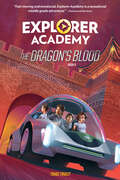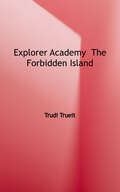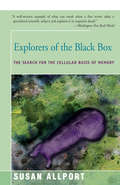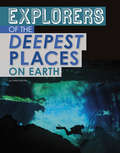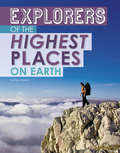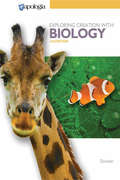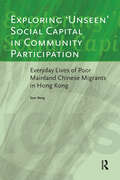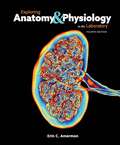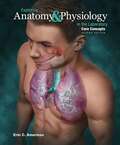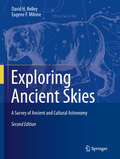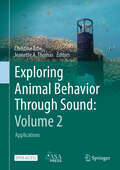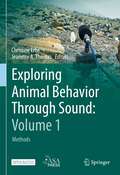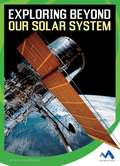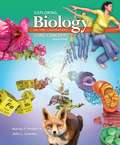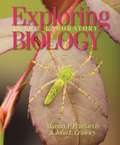- Table View
- List View
Explorer Academy: The Dragon's Blood (Explorer Academy)
by Trudi TrueitAn explosive revelation and a familiar face in the sixth book in this adventure-packed series. Still reeling from the life-changing discovery he found buried in the mysterious archive, Cruz Coronado grapples with an important secret as the gang heads to China in search of the second-to-last piece of the cipher. Under the watchful eye of a new adviser, life on the ship returns to almost normal...Almost. Just as things seem to be going smoothly, a familiar face shocks Cruz back into reality, and the final piece in this life-and-death scavenger hunt veers toward a dead end. Explorer Academy features: Gripping fact-based fiction plot that inspires curiosity with new technology and innovations; Amazing inventions and gadgets; A cast of diverse, relatable characters; Secret clues, codes, and ciphers to track down within the text; Vibrant illustrations, Elements of STEAM; National Geographic explorer profiles in The Truth Behind Section. Complete your collection with: The Nebula Secret (1) The Falcon's Feather (2) The Double Helix (3) The Star Dunes (4) The Tiger's Nest (5) Explorer Academy Code-Breaking Adventure Explorer Academy Ultimate Activity Challenge Explorer Academy Field Journal Explorer Academy Future Tech
Explorer Academy: The Forbidden Island (Explorer Academy Series #7)
by Trudi TrueitAfter a near-death encounter and a disappointing message from his mother, Cruz Coronado feels as though he's running out of time to complete the cipher. Can he outsmart Nebula once and for all? Or has his journey come to a permanent end?
Explorer Academy: The Forbidden Island (Explorer Academy)
by Trudi TrueitA heart-pounding final showdown changes the life of Cruz Coronado forever in the seventh and final book in this thrilling fact-based fiction series. Amid assignments that take the Explorer Academy recruits from the iceberg-filled waters of Antarctica to the bone-dry deserts of Argentina, Cruz Coronado is scrambling to complete the last piece of the cipher. With Nebula agents and the elusive explorer spy still out there, his opportunity to recover his mother's world-changing formula is slipping away. But as Cruz has learned from his time aboard Orion, true explorers must never give up. Even after completing dozens of high-risk missions and traveling to all seven continents, Cruz could never prepare himself for one ultimate surprise. Explorer Academy features: Gripping fact-based fiction plot that inspires curiosity with new technology and innovations; amazing inventions and gadgets; a cast of diverse, relatable characters; secret clues, codes, and ciphers to track down within the text; vibrant illustrations; elements of STEAM; National Geographic explorer profiles in the "Truth Behind" section. Complete your collection with: The Nebula Secret (1) The Falcon's Feather (2) The Double Helix (3) The Star Dunes (4) The Tiger's Nest (5) The Dragon's Blood (6) Explorer Academy Codebreaking Activity Adventure Explorer Academy Ultimate Activity Challenge Explorer Academy Field Journal Explorer Academy Future Tech
Explorers of Deep Time: Paleontologists and the History of Life
by Roy PlotnickPaleontology is one of the most visible yet most misunderstood fields of science. Children dream of becoming paleontologists when they grow up. Museum visitors flock to exhibits on dinosaurs and other prehistoric animals. The media reports on fossil discoveries and new clues to mass extinctions. Nonetheless, misconceptions abound: paleontologists are assumed only to be interested in dinosaurs, and they are all too often imagined as bearded white men in battered cowboy hats.Roy Plotnick provides a behind-the-scenes look at paleontology as it exists today in all its complexity. He explores the field’s aims, methods, and possibilities, with an emphasis on the compelling personal stories of the scientists who have made it a career. Paleontologists study the entire history of life on Earth; they do not only use hammers and chisels to unearth fossils but are just as likely to work with cutting-edge computing technology. Plotnick presents the big questions about life’s history that drive paleontological research and shows why knowledge of Earth’s past is essential to understanding present-day environmental crises. He introduces readers to the diverse group of people of all genders, races, and international backgrounds who make up the twenty-first-century paleontology community, foregrounding their perspectives and firsthand narratives. He also frankly discusses the many challenges that face the profession, with key takeaways for aspiring scientists. Candid and comprehensive, Explorers of Deep Time is essential reading for anyone curious about the everyday work of real-life paleontologists.
Explorers of the Black Box: The Search for the Cellular Basis of Memory
by Susan AllportExplorers of the Black Box is a scientific adventure story. The "Black Box" is the brain. The "Explorers" are neuroscientists in search of how nerve cells record memories, and they are as ruthless and dauntless as any soldiers of fortune. The book centers around the early, often-controversial research Nobel Prize-winner Eric Kandel. It takes readers behind the scenes of laboratories at Woods Hole, Columbia, Yale, and Princeton to create an absorbing account of how the brain works and of how science itself works.
Explorers of the Coldest Places on Earth (Extreme Explorers)
by Nel YomtovFor many decades, courageous men and women have ventured to our planet's foreboding icy regions. These brave explorers risk life and limb in the name of science or for the thrill of adventure. Who are these thrill seekers and why do they do it? Turn the pages to find out!
Explorers of the Deepest Places on Earth (Extreme Explorers)
by Peter MavrikisDid you know the deepest parts of the ocean are still largely unexplored? Courageous explorers risk their lives to go to these great ocean depths. Other explorers journey into deep volcanoes, caves, and mines. Who are they and why are they seeking a glimpse of the world deep below the earth's surface? Turn the pages to find out!
Explorers of the Highest Places on Earth (Extreme Explorers)
by Peter MavrikisThe amount of available oxygen at the highest place on Earth is just under 7%. Explorers risk their lives and test their lungs traveling to these great heights atop mountains. Who are these adventurers and why do they do it? Turn the pages to find out!
Explorers of the New World
by Tom Casteel Carla MooneyExplorers of the New World: Discover the Golden Age of Exploration offers a fascinating look at the explorers and their voyages during the Age of Exploration and Discovery. Readers ages 9-12 can delve into the expeditions of Vasco da Gama, Christopher Columbus, Ferdinand Magellan, John Cabot, Hernán Cortés, and more. Using common household items and minimal supervision, kids enjoy 22 hands-on activities to help them learn about these legendary explorers and their voyages. Discover how the adventures of a few people 500 years ago changed world history.Projects include creating and using a compass, learning to tie a sailor's knot, and baking and eating sea biscuits. Along with detailed, step-by-step instructions for each project, Explorers of the New World includes biographical sidebars, engaging illustrations, interesting facts, and vocabulary words that allow kids to experience this era in a fun, interactive way.
Explorers of the Remotest Places on Earth (Extreme Explorers)
by Nel YomtovOf all the places to explore on Earth, remote places are often said to be the most challenging. Yet brave explorers travel to the most remote corners of the world, pushing through vast forests, icy polar regions, and other landscapes. Who are these adventurers and why do they do it? Turn the pages to find out!
Exploring Anatomy & Physiology in the Laboratory (Third Edition)
by Erin C. AmermanThis comprehensive manual is appropriate for a two-semester anatomy and physiology laboratory course. Through focused activities and by eliminating redundant exposition and artwork found in most primary textbooks, this manual complements the lecture material and serves as an efficient and effective tool for learning in the lab.
Exploring Creation with Biology
by Vicki DincherAs scientific studies advance farther out into the universe as well as deeper into the microscopic world, scientists continue to ask, “What is life?” Biology is the study of life, and this 3rd edition of Exploring Creation with Biology teaches not only the science of how we begin to answer the bigger questions defining life, but also includes meaningful discussions on Creation and Creator. <p><p> This updated high school biology course was redesigned to help students see and understand the beauty of life that surrounds us. Full-page infographics were created to help students grasp the concepts discussed in the text and go beyond simple illustrations. <p> As a college-prep high school biology course, it will set the stage for success in homeschooled high school years, prepare students for college level courses, and give them an understanding of the basic biological world that surrounds them each day of their lives so that they can appreciate the real-world relevance of scientific inquiry. <p> Opening with the studies of the process of science, students learn about observations and inferences, hypotheses, experiments, and scientific theories and laws. They are taught to see the limitations of science and learn about the tools used in biological studies. <p> In their studies of life, students will delve into the chemistry of life from atoms to the chemical structures that make life, as we know it, possible. They will explore the ecology that surrounds life as they investigate ecosystems, biomes, populations, and communities. <p> An in-depth study of cell structure and function, cellular energy, DNA, proteins, and cell cycles will help students comprehend heartier materials as they advance to learn about genetics – inheritance, disorders, and technology, as well as the role of genetics in evolution. <p> Students will also learn about prokaryotes, viruses, protists, and fungi. They will delve deep into the fascinating world of plants and animals. And all of their learned knowledge will be backed by hands-on experimentation that takes their book knowledge and applies it to concepts that they can comprehend. <p> At Apologia, we believe that students’ educations should prepare them for life, not just an academic year. This creation-based science course will create the strong foundation students can rely upon as they grow in their awe and wonder of our world. <p> At the completion of this course, students will be able to understand the vocabulary of biology so that they can engage in true scientific discourse. Their strong background in the scientific method regarding experimentation, field studies, microscopy, and dissection will also allow them to be well equipped to analyze data that they will encounter throughout their lifetimes.
Exploring 'Unseen' Social Capital in Community Participation: Everyday Lives of Poor Mainland Chinese Migrants in Hong Kong (ICAS Publications series)
by Sam WongThis book argues that using social capital to eradicate poverty is less likely to succeed because the mainstream neoinstitutional approach mistakenly assumes that social capital necessarily benefits poor people. This inadequacy calls for a re-assessment of human motivations, institutional dynamics and structural complexity in social capital building. Using ethnographic and participatory methods, this book calls for an exploration of ‘unseen’ social capital which is intended to challenge the mainstream understanding of ‘seen’ social capital. As such this book is useful to policy makers and practitioners.
Exploring Agrodiversity (Issues, Cases, and Methods in Biodiversity Conservation)
by Harold BrookfieldSmall farmers are often viewed as engaging in wasteful practices that wreak ecological havoc. Exploring Agrodiversity sets the record straight: Small farmers are in fact ingenious and inventive and engage in a diverse range of land-management strategies, many of them resourcefully geared toward conserving resources, especially soil. They have shown considerable resilience in the face of major onslaughts against their way of life by outsiders and government.Using case studies from Africa, Asia, Latin America, and the Pacific, this book provides in-depth analysis of agricultural diversity and explores its history. The book also considers the effect of the "gene revolution" on small farmers and reviews the effects of the "green revolution" in Asian countries. In conclusion, it questions whether the diverse agricultural practices employed by small farmers can survive modern pressures and the global ambitions of the biotechnology industry.
Exploring Anatomy & Physiology in the Laboratory
by Erin C. AmermanMany years ago, when I first started teaching anatomy and physiology, my biggest frustration with the course came from the laboratory. It seemed as if I were pulling teeth to get my students interested in the lab material and most students were unable to make the connections between lecture and lab.
Exploring Anatomy & Physiology in the Laboratory
by Erin C. AmermanExploring Anatomy & Physiology in the Laboratory (EAPL) is one of the best-selling A&P lab manuals on the market. Its unique, straightforward, practical, activity-based approach to the study of anatomy and physiology in the laboratory has proven to be an effective approach for students nationwide. This comprehensive, beautifully illustrated, and affordably priced manual is appropriate for a two-semester anatomy and physiology laboratory course. Through focused activities and by eliminating redundant exposition and artwork found in most primary textbooks, this manual complements the lecture material and serves as an efficient and effective tool for learning in the lab.
Exploring Anatomy & Physiology in the Laboratory Core Concepts
by Erin C. AmermanThis brief version of Exploring Anatomy and Physiology in the Laboratory, 2e, is intended for one-semester anatomy and physiology courses geared toward allied health students. Exploring Anatomy & Physiology Laboratory: Core Concepts, by Erin C. Amerman is a comprehensive, beautifully illustrated, and affordably priced lab manual that features an innovative, interactive approach to engage your students and help ensure a deeper understanding of A&P.
Exploring Ancient Skies
by Eugene F. Milone A. F. Aveni David H. KelleyExploring Ancient Skies brings together the methods of archaeology and the insights of modern astronomy to explore the science of astronomy as it was practiced in various cultures prior to the invention of the telescope. The book reviews an enormous and growing body of literature on the cultures of the ancient Mediterranean, the Far East, and the New World (particularly Mesoamerica), putting the ancient astronomical materials into their archaeological and cultural contexts. The authors begin with an overview of the field and proceed to essential aspects of naked-eye astronomy, followed by an examination of specific cultures. The book concludes by taking into account the purposes of ancient astronomy: astrology, navigation, calendar regulation, and (not least) the understanding of our place and role in the universe. Skies are recreated to display critical events as they would have appeared to ancient observers--events such as the supernova of 1054 A.D., the "lion horoscope," and the Star of Bethlehem. Exploring Ancient Skies provides a comprehensive overview of the relationships between astronomy and other areas of human investigation. It will be useful as a reference for scholars and as a text for students in both astronomy and archaeology, and will be of compelling interest to readers who seek a broad understanding of our collective intellectual history.
Exploring Animal Behavior Through Sound: Applications
by Jeanette A. Thomas Christine ErbeThis open-access book offers a profound exploration of the acoustic world of animals. Organized into nine chapters by taxonomy—invertebrates, insects, amphibians, reptiles, fishes, birds, and mammals (subterranean, terrestrial, and marine)—it delves into sound production, sound reception, sound function, and the impacts of noise on these creatures. As the second volume of Exploring Animal Behavior Through Sound, it builds upon the bioacoustic concepts and methodologies established in the first volume. By attuning ourselves to the sounds of nature, we can gain valuable insights into animal behavior, distribution, and demographics, as well as their habitat characteristics and needs, and the effects of noise on their behavior. This book will serve as a valuable resource for students and researchers in animal ecology seeking to incorporate acoustics into their research toolkit, as well as for environmental managers in industry and government.
Exploring Animal Behavior Through Sound: Methods
by Jeanette A. Thomas Christine ErbeThis open-access book empowers its readers to explore the acoustic world of animals. By listening to the sounds of nature, we can study animal behavior, distribution, and demographics; their habitat characteristics and needs; and the effects of noise. Sound recording is an efficient and affordable tool, independent of daylight and weather; and recorders may be left in place for many months at a time, continuously collecting data on animals and their environment. This book builds the skills and knowledge necessary to collect and interpret acoustic data from terrestrial and marine environments. Beginning with a history of sound recording, the chapters provide an overview of off-the-shelf recording equipment and analysis tools (including automated signal detectors and statistical methods); audiometric methods; acoustic terminology, quantities, and units; sound propagation in air and under water; soundscapes of terrestrial and marine habitats; animal acoustic and vibrational communication; echolocation; and the effects of noise. This book will be useful to students and researchers of animal ecology who wish to add acoustics to their toolbox, as well as to environmental managers in industry and government.
Exploring Animal Science
by Frank B. FlandersEXPLORING ANIMAL SCIENCE offers educators the perfect tool for teaching animal agriculture: one that balances the academic background critical to building a strong foundation in fundamental science with the practical, production-oriented content vital to work in the real world. Its coverage spans a variety of areas like nutrition, anatomy and physiology, biotechnology, biosecurity, and genetics and animal reproduction. Each topic is presented in a straightforward manner that first investigates the basics, and then delves further into its practical application to the production, care, and management of animal agriculture. Ideal for a range of students, from late middle school to early high school, this unique approach is sure to engage by drawing such powerful connections between academics and real-life animal-based scenarios and situations. It also includes a wide range of activities that will fit any animal science classroom, making it an appealing choice for teachers and students alike.
Exploring Beyond Our Solar System (Wonders of Space)
by Patricia HutchisonCompelling narrative nonfiction text presents the story of the scientists who are exploring beyond our solar system, featuring the intrigue and excitement behind their missions. Additional features to aid comprehension include a table of contents, fact-filled captions and callouts, infographics, a glossary, a listing of source notes, sources for further research, and an introduction to the author.
Exploring Biological Anthropology: The Essentials
by Craig Britton Stanford John Scott Allen Susan C. AntónExploring Biological Anthropology: The Essentials combines concise coverage of the foundations of the field with modern innovations and discoveries, helping students understand, and get excited about, the discipline. Because the authors conduct research in three of the main areas of biological anthropology–the human fossil record (Susan Antón), primate behavior and ecology (Craig Stanford), and human biology and the brain (John Allen)–they offer a specialist approach that engages students and gives them everything they need to master the subject. The Fourth Edition continues to present traditional physical anthropology within a modern Darwinian framework, and includes coverage of contemporary discoveries to highlight the ever-increasing body of knowledge in biological anthropology.
Exploring Biology In The Laboratory: Core Concepts
by Murray P. Pendarvis John L. CrawleyExploring Biology in the Laboratory: Core Concepts is a comprehensive manual appropriate for introductory biology lab courses. This edition is designed for courses populated by nonmajors or for majors courses where abbreviated coverage is desired. Based on the two-semester version of Exploring Biology in the Laboratory, 3e, this Core Concepts edition features a streamlined set of clearly written activities with abbreviated coverage of the biodiversity of life. These exercises emphasize the unity of all living things and the evolutionary forces that have resulted in, and continue to act on, the diversity that we see around us today.
Exploring Biology in the Laboratory
by Murray Paton Pendarvis John L. CrawleyExploring Biology in the Laboratory is a comprehensive manual appropriate for one- or two-semester introductory general biology lab courses. Clearly-written and engaging activities emphasize the unity of all living things and the evolutionary forces that have resulted in, and continue to act on, the diversity that we see all around us.
